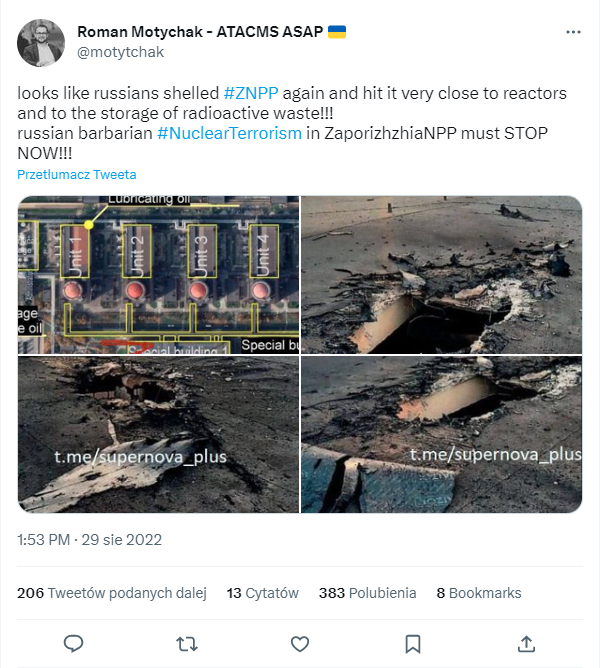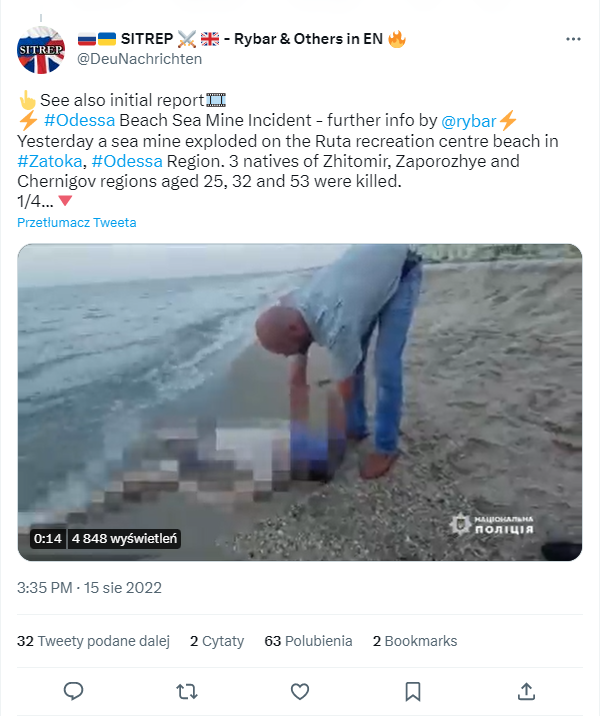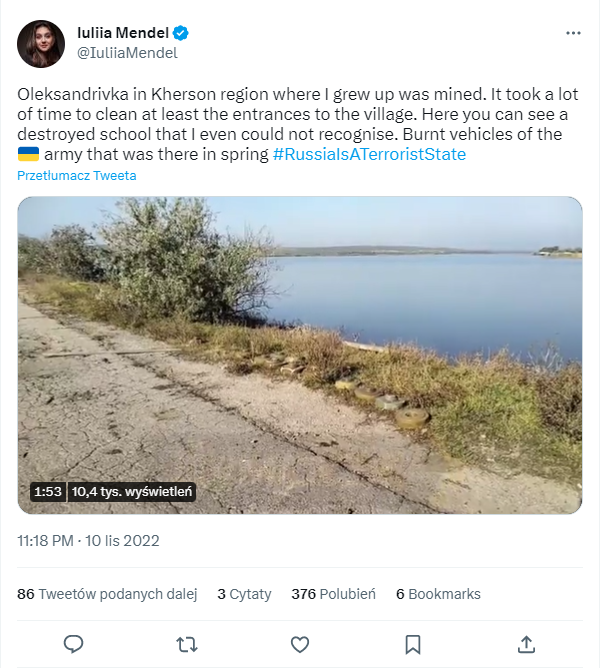Media monitoring in the fight against war disinformation
How does Open Source Intelligence (OSINT) influence the perception of modern warfare? What is OSINT anyway? In the article below, we will present how media monitoring tools improve OSINT operations.
The growing role of Open Source Intelligence (OSINT)
In the era of universal access to information about the amount of data that we are forced to process every day, it leads to information overload. As a consequence, we often encounter the phenomenon of information noise. As a result, a change in the paradigm of searching for content in open sources is observed – the recipient is increasingly being forced to check the credibility of the published materials.
Social changes at the turn of the 20th and 21st centuries related to the digitization of economic, social and public life have significantly increased the role of OSINT. The volume of data published on the Internet began to grow exponentially. In 2015, IBM reported that 90% of all data ever recorded was created in two years (2013–2015). The volume of the information resource is growing exponentially, doubling every three years. According to Cybersecurity Ventures, by 2030, 90% of the population over the age of 6 will be online. This means that over 7.5 billion people will share information about themselves through social media and other similar platforms.
Digital data will continue to grow in importance and popularity, playing a crucial role in the political, private, business and many other fields. It is fully understandable that OSINT has become a key element of strategy in many industries. Therefore, the question can be asked, referring to current events, how will its growing role affect the conduct of armed conflicts?
For the record, let’s define exactly what this technique is. OSINT (Open Source Intelligence) is a technique of obtaining information from open and public sources. It is a completely legal way of obtaining data about e.g. companies, people or events. OSINT should not be equated with illegal espionage or illegal activities such as password cracking or spoofing. This is a partially or fully automated process. In Poland, it is also referred to as “white intelligence“.
OSINT data sources
OSINT data sources are:
- social media,
- blogs and websites,
- search engines (e.g. Google, including Google Graphics and Google Maps),
- internet forums,
- internet archives (e.g. websites),
- online registers (e.g. of vehicles or insurance policies),
- databases available on the web (e.g. government or business data),
- the Public Information Bulletins,
- public company documents,
- media monitoring tools,
- exchange quotations,
- online debt exchange,
- available network services (open ports),
- IP addresses,
- Deep Web,
- Dark Web.
It should also be remembered that OSINT still analyzes traditional media such as the press, radio and television.
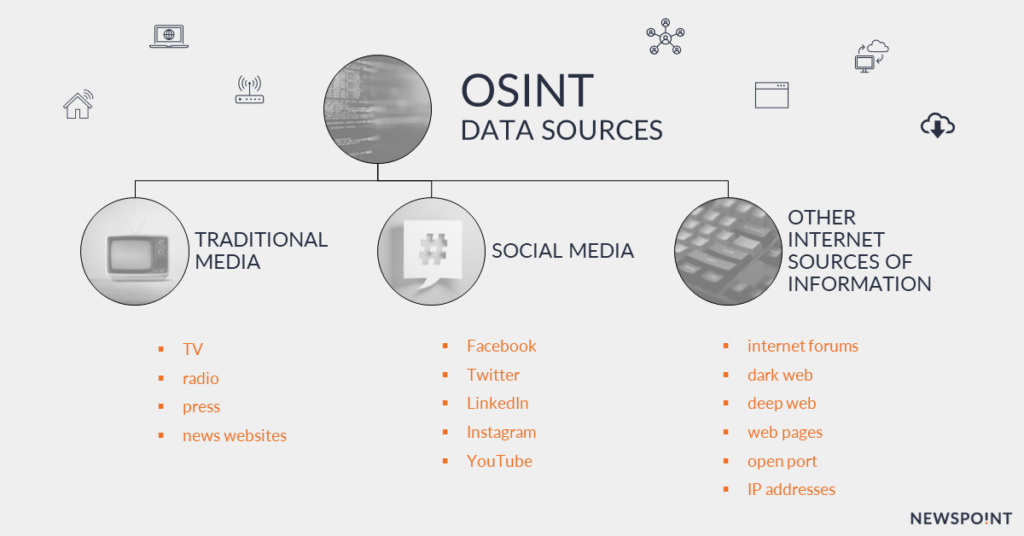
OSINT plays an important role in identifying internal and external threats in the digital environment. After collecting the necessary data, specialists take appropriate actions to avoid undesirable events, plan a strategy or identify people who threaten a given entity. In particular, they filter and analyze the collected data, present the results in consistent reports, and propose or implement measures to prevent potential threats.
Often, OSINT activities use specialized tools to access less obvious information (which, while publicly available, is not always easily identifiable). The tools (usually in form of an online platforms) are widely available and in most cases easy to use. For this reason, interest in “SOCMINT” is growing. SMI or SOCMINT can be defined as the process of collecting and analyzing data gathered from social media in order to obtain useful information.
OSINT and the course of the war
The constantly expanding range of publicly available sources of information has led to a change in the contemporary perception of armed conflict. Ease of access to materials showing the battlefield, by making them available in social media, has meant that they are increasingly redistributed in traditional media (direct reports of participants of war events, often go to television broadcasts). This causes the viewer to engage emotionally with witnesses presenting tragic materials. For this reason, war, like any other event, becomes a media phenomenon. As a result, the war begins to turn into a tabloid (publishers compete with each other to publish more extreme content faster and in larger quantities in order to attract the viewer’s attention). It also affects the public debate. As a consequence, states at war (such as Ukraine today) face the need to undertake PR activities. This applies not only to the transfer of information about the opponent, the propagation of a specific narrative, but also to the production of such materials as graphics or memes. Media and political activities must focus on adopting a strategy focused on gaining support for the actions taken.
In the „old fashioned media”, the information presented to the recipients is subject to appropriate filtration in terms of credibility. It should be recalled here that in earlier decades about armed conflicts, such as the war in Iraq or Afghanistan, often the only source of information from the front was the official announcements of the Ministry of Defence. Currently, in the world of social media and Internet portals, each event participant has the ability to communicate with the world. This increases the risk of spreading fake news. Global access to information often hinders military operations, gives the parties to the conflict the opportunity to analyze enemy positions, routes for the delivery of military equipment, identify key points in the supply chain, and recognize and analyze the tactics used.
The need to verify the news has forced many countries to recognize disinformation as a growing threat. Therefore, special units began to be formed, created to conduct information warfare. An example of such an institution is the Center for Emerging Technology and Security. This unit specializes in obtaining data from open information sources. Its task is to counteract false information and obtain data on the location and intentions of the enemy. The leader in this type of analysis is one of the non-governmental organizations that uses The Global Authentication Project (a community of OSINT practitioners and people supporting the work of the organization) to create a map of war crimes. Verified materials circulating in social media are added to the map. Then, specific locations of events are determined to superimpose the data on the timeline.
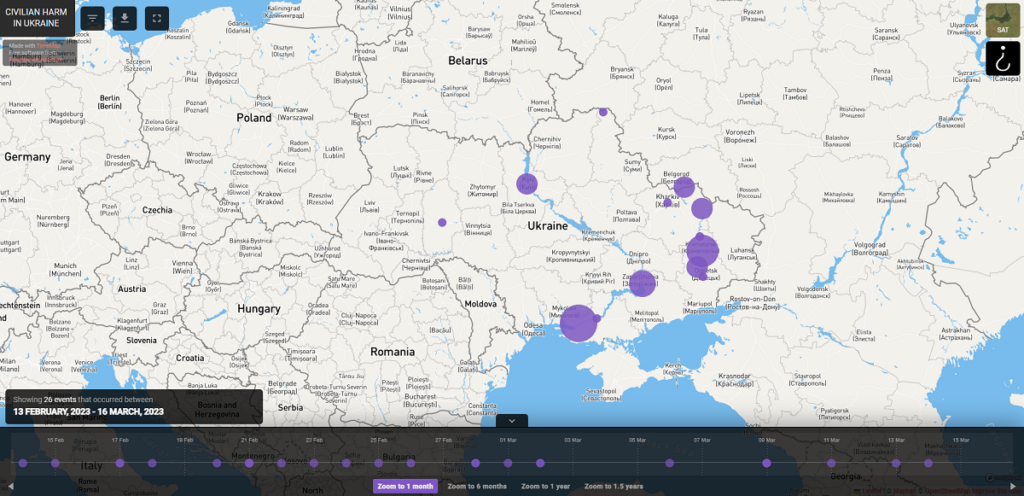
The OSCE report on war crimes (including genocide) committed in Ukraine was based on information from open sources and the work of think tanks. In the introduction, the authors of the report point out that data from open source information played an important role in its preparation. In order to identify entries in the problem described above, a media monitoring tool can be used. By appropriately defining keywords (in this case in English) such as: russians, barbarian, shelling, #NuclearTerrorism, mine, explode, #RussiaIsATerroristState, specific entries will be searched in the appropriately set context:
Using the Newspoint tool, you can also identify areas of discussion (types of media), catch opinion leaders, focus on entities posting anti-Ukrainian entries or identify Internet trolls. After determining the problem and setting the appropriate queries in the application, it is also possible to receive real-time notifications to the mailbox.
In the initial stage of the research, it is necessary to determine the information and main topics, and thus the appropriate selection of keywords. For the analysis presented below, the following keywords were monitored (most in Polish, including declensions): #StopBanderyzacji; #StopBanderyzacjiPolski; #StopUkrainizacjiPolski; #StopUkrainizationOfPoland; #ToNieNaszaWojna; Banderowcy; Banderowiec; Banderowski; Banderyzacja; banderyzm; chachły; ludobójstw* ukrain*; niebiańska jerozolima; okrucieństwo Ukraińców; przesiedlenia ukrain; przywileje ukrain*; rzeź wołyńska; Stop Banderyzacji; Stop Banderyzacji Polski; Stop ukrainizacji Polski; Stop Ukrainization Of Poland; To Nie Nasza Wojna; ukrai* nacjonal*; ukrainizacja; ukropol; ukropol; ukropolin; ukropoliniak; ukrowie; ukrpol; ukry; upa nacjonal*; upadlina; upadliniec; upadlińcy; upaina; urodzin* bander*; wołyń.
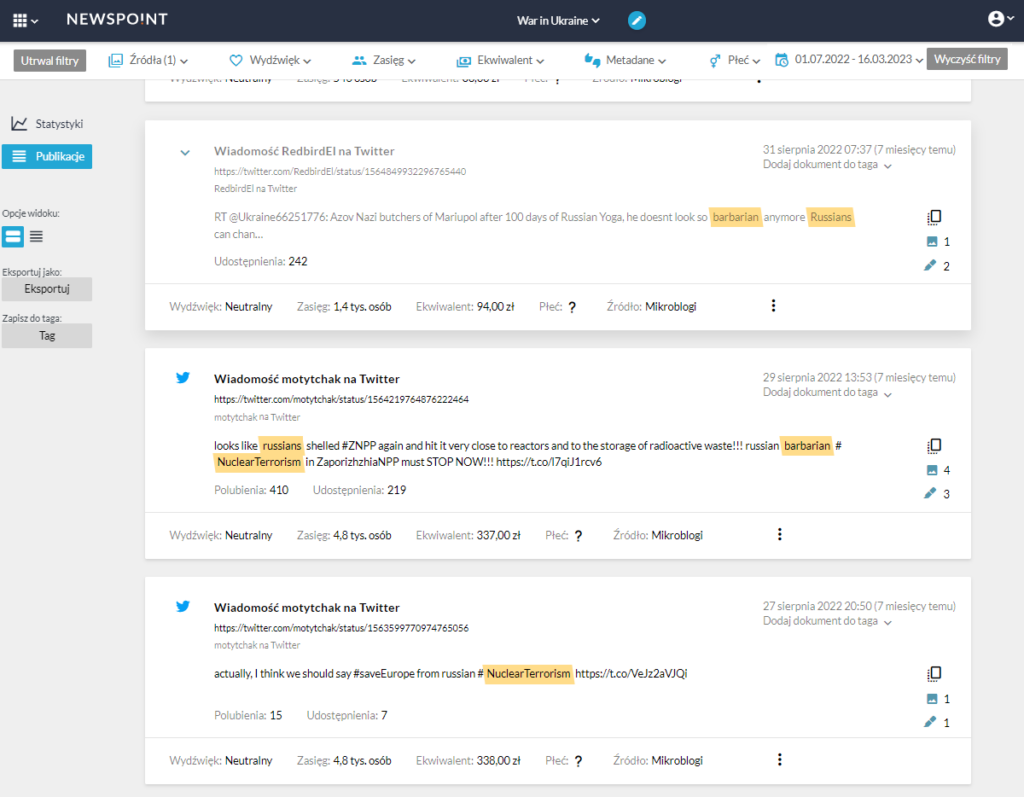
All entries in a negative context were analyzed. Publications containing purely informational materials and reports of events were omitted. The study was conducted on the basis of materials collected in the period from October 1, 2022 to February 28, 2023.
The automated depth analysis was prepared on the basis of Polish-language materials. In total, 271,934 entries were recorded in social media, forums and blogs.
In October, November and December 2022, there were 47,140, 65,048 and 50,706 mentions, respectively. In January and February 2023, 55,600 and 53,440 publications were recorded for each of them. The monthly average for each of the analyzed months is 54,386.8 materials.
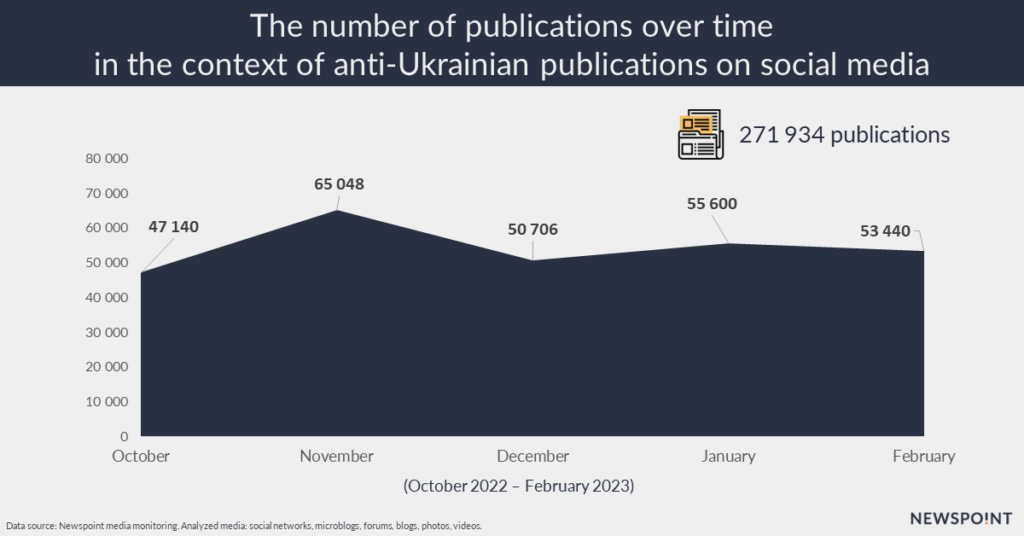
Most anti-Ukrainian publications were recorded on microblogs (Twitter, Wykop) 62.16%. On Facebook, posts accounted for 18.02%, while on YouTube 13.10%. On forums and blogs, the percentage of posted entries was 3.27% and 2.16%, respectively, and on Instagram 1.29%. The reach of monitored materials amounted to 149 million.
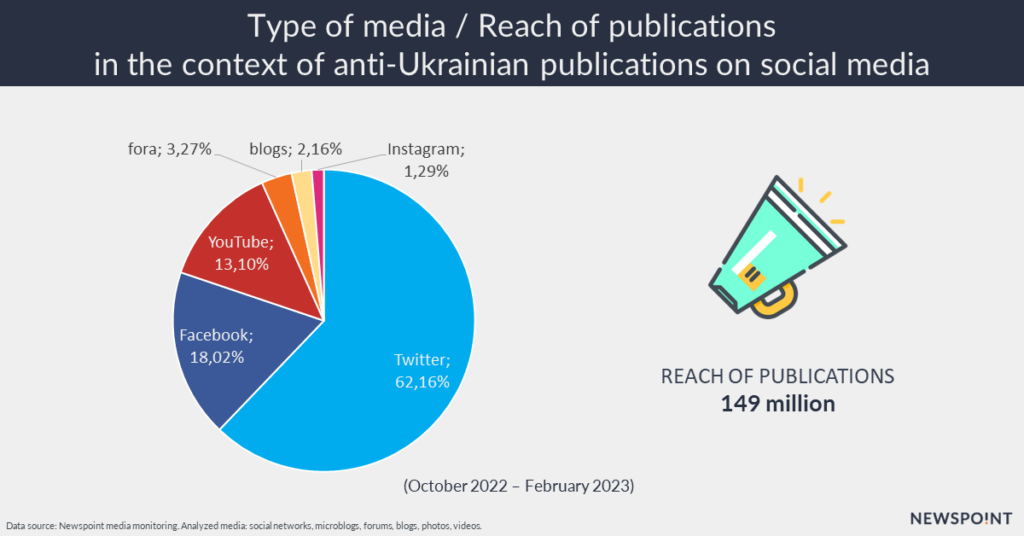
If the goal was to identify the main entities responsible for publishing anti-Ukrainian content in Polish, the Newspoint tool would be the most appropriate tool for this task. Thanks to the application, you can catch users posting the largest number of publications in a given topic as well as show opinion leaders. For example, a few selected accounts with the largest number of anti-Ukrainian entries are presented below.
Authors (meeting the search criteria) on whose profiles the largest number of entries was recorded, and at the same time their publications were most willingly shared:
- Andrzej Palka #StopUkrainizacjiPolski @andrzej_palka (Twitter);
- Piotr Wielki #stopukrainizacjiPolski ***** *** @PiotrWielki5 (Twitter);
- FLUVIUSZ #StopUkrainizacjiPolski,#stop447@Fluviusz (Twitter);
- Stop Ukropolin 🇵🇱 🇦🇲 @siloamx (Twitter);
- Kordecki #StopUkrainizacjiPolski @MarSkiXX (Twitter).
What is also important from the point of view of the problem described above is the monitoring of posted entries in real time. Newspoint immediately sends notifications when the publication appears in the media. Real-time notifications can make it easier, for example, to identify enemy troops. When an entry appears in social media in the context of the location of the army, this information will be sent to the e-mail immediately.
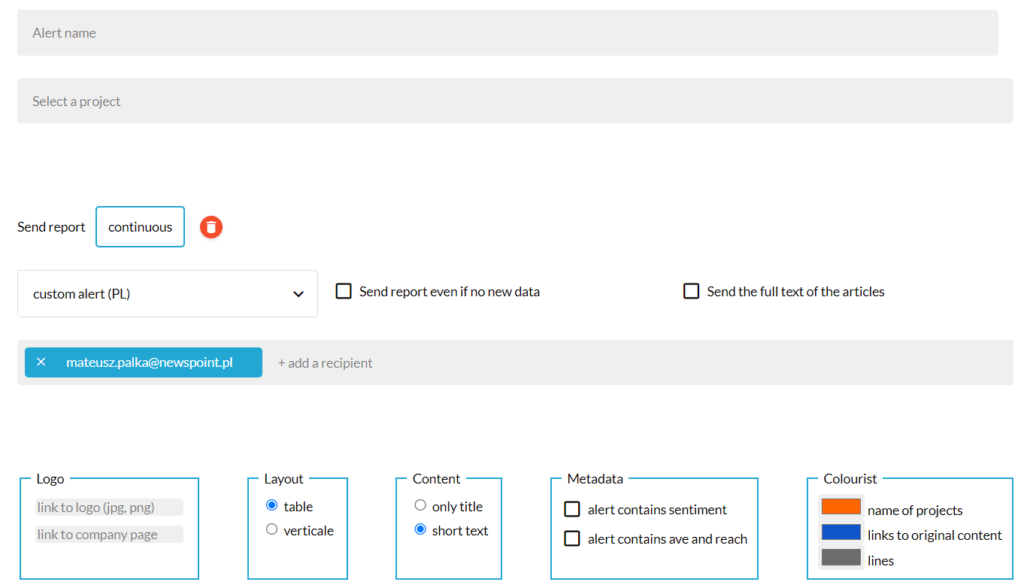
Nowadays, a lot of important information is publicly available. All that is required is the ability to search and distinguish interesting sources from completely useless ones. By using tools to help run OSINT, users are able to generate specific content. Although OSINT has many positive applications, participation in a global community allows anyone to obtain sensitive data (access to image and personal information, family knowledge, log of activities and habits). We must remember that every time we share personal information online that we don’t want outsiders to see – the situation is the same in the case of war. All available materials regarding the movement of troops or related to activities resulting from the ongoing armed conflict are ready-made material that can be used by the enemy.
Reference list:
Przemysław Aftański, Społeczeństwo informacyjne – nowy wymiar informacji, Uniwersytet Rzeszowski, Rzeszów 2011 r.
Barbara Konopka, Szum informacyjny i jego rola w kształtowaniu warunków medialnych i kulturowych, 2020 r., Transformacje, 1-2 (104-105), s. 167-187.
Katarzyna Jarczewska-Walendziak, Wykorzystywanie otwartych źródeł informacji przez służby śledcze, w: Toruńskie Studia Bibliograficzne 2017, nr 1 (18) półrocznik.
Beata Gałek, Nowe instrumenty współczesnych operacji pozainformacyjnych, 2018 r.
Błażej Sajduk, Teoretyczne przesłanki wykorzystania ustrukturyzowanych technik analizy informacji w procesie analizy politycznej, w: Politeja – Pismo Wydziału Studiów Międzynarodowych i Politycznych Uniwersytetu Jagiellońskiego, 19/2022, s. 119-142.
Wielki wybuch danych, https://przemyslprzyszlosci.gov.pl/wielki-wybuch-danych/
OSINT a cyberbezpieczeństwo firm i organizacji, https://resilia.pl/blog/osint-a-cyberbezpieczenstwo-firm-i-organizacji/
Center for Security and Emerging Technology, https://cetas.turing.ac.uk/about
Global Authentication Project, https://twitter.com/bellingcatgap
Bellingcat, https://www.bellingcat.com/
OBWE a wojna na Ukrainie, https://www.pism.pl/publikacje/obwe-a-wojna-na-ukrainie
Raport OBWE ws. Ukrainy wskazuje na rosyjskie zbrodnie wojenne i zbrodnie przeciwko ludzkości, https://www.gazetaprawna.pl/wiadomosci/swiat/artykuly/8496977,obwe-raport-ukraina-rosja-zbrodnie-wojenne-przeciw-ludzkosci.html
